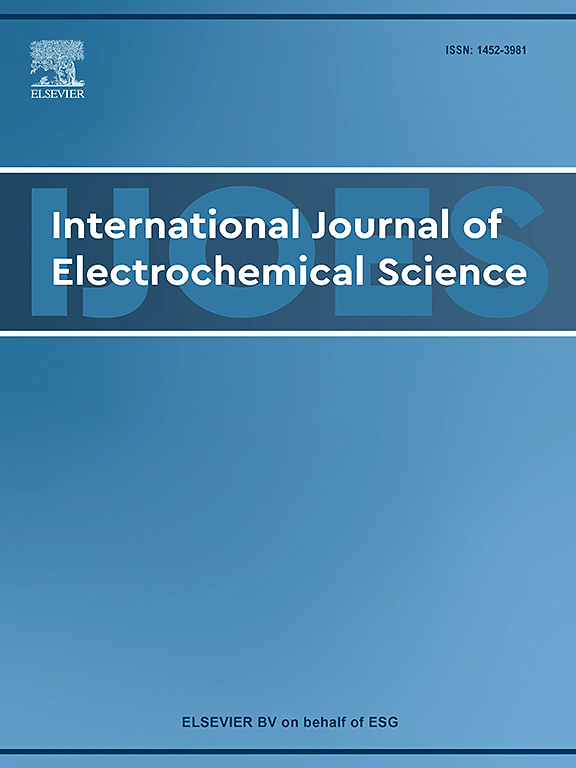Electrochemical determination of the ovarian cancer biomarker CA125 using TiO₂–ZnO nanocomposites
IF 2.4
4区 化学
Q4 ELECTROCHEMISTRY
International Journal of Electrochemical Science
Pub Date : 2025-07-05
DOI:10.1016/j.ijoes.2025.101119
引用次数: 0
Abstract
Early and accurate detection of ovarian cancer is essential for improving patient outcomes, as most cases are diagnosed at an advanced stage. Cancer antigen 125 (CA125) is a clinically established biomarker that plays a critical role in the diagnosis, prognosis, and recurrence monitoring of epithelial ovarian carcinoma. This study presents a dual-channel electrochemical platform employing ZnO@TiO2 nanotube arrays for the immunoanalysis of CA125 in complex biological matrices. The nanostructured electrode, fabricated through a sequential hydrothermal and annealing process, exhibited vertically aligned tubular morphology with a mean length of ∼2.5 µm and shell thickness of ∼20 nm. Electrochemical measurements leveraged dopamine and cytosine as reduction and oxidation probes, respectively, enabling orthogonal signal acquisition. Differential pulse voltammetry revealed wide linear response ranges: 0.1–1000 mU∙mL−1 for cytosine (R² = 0.996; LOD = 0.0002 mU∙mL−1) and 0.1–100 mU∙mL−1 for dopamine (R² = 0.992; LOD = 0.0025 mU∙mL−1). Impedance spectroscopy confirmed systematic resistance increases during antibody immobilization and antigen binding. The sensor demonstrated excellent reproducibility (RSD ≤ 8.9 %), signal stability over 30 days (≥89.1 % retention), and selectivity against six common interferents with < 5 % deviation. Application in 0.2 % diluted serum showed recoveries from 99.6 % to 100.0 % and RSDs < 2.01 %, validating its performance in real matrices. The combination of core–shell architecture, dual-probe mechanism, and surface regeneration capability positions this system as a promising diagnostic platform for clinical biosensing.
tio2 -ZnO纳米复合材料电化学测定卵巢癌生物标志物CA125
卵巢癌的早期和准确检测对于改善患者的预后至关重要,因为大多数病例是在晚期诊断出来的。癌抗原125 (Cancer antigen 125, CA125)是一种临床确定的生物标志物,在上皮性卵巢癌的诊断、预后和复发监测中发挥着关键作用。本研究提出了一种双通道电化学平台,采用ZnO@TiO2纳米管阵列对复杂生物基质中的CA125进行免疫分析。通过连续水热和退火工艺制备的纳米结构电极具有垂直排列的管状形貌,平均长度为~ 2.5 µm,壳厚为~ 20 nm。电化学测量利用多巴胺和胞嘧啶作为还原和氧化探针,分别实现正交信号采集。差分脉冲伏安法对胞嘧啶的线性响应范围为0.1 ~ 1000 mU∙mL−1 (R²= 0.996;多巴胺的LOD = 0.0002 mU∙mL−1),0.1 ~ 100 mU∙mL−1 (R²= 0.992;LOD = 0.0025 mU∙mL−1)。阻抗谱证实,在抗体固定和抗原结合过程中,系统的抗性增加。该传感器具有良好的再现性(RSD≤8.9 %),30天内信号稳定性(≥89.1% %保留率),对六种常见干扰的选择性(偏差为<; 5 %)。应用于0.2 %稀释血清中,回收率为99.6 % ~ 100.0 %,rsd为 2.01 %,验证了其在真实基质中的性能。核壳结构、双探针机制和表面再生能力的结合使该系统成为一个有前途的临床生物传感诊断平台。
本文章由计算机程序翻译,如有差异,请以英文原文为准。
求助全文
约1分钟内获得全文
求助全文
来源期刊
CiteScore
3.00
自引率
20.00%
发文量
714
审稿时长
2.6 months
期刊介绍:
International Journal of Electrochemical Science is a peer-reviewed, open access journal that publishes original research articles, short communications as well as review articles in all areas of electrochemistry: Scope - Theoretical and Computational Electrochemistry - Processes on Electrodes - Electroanalytical Chemistry and Sensor Science - Corrosion - Electrochemical Energy Conversion and Storage - Electrochemical Engineering - Coatings - Electrochemical Synthesis - Bioelectrochemistry - Molecular Electrochemistry

 求助内容:
求助内容: 应助结果提醒方式:
应助结果提醒方式:


